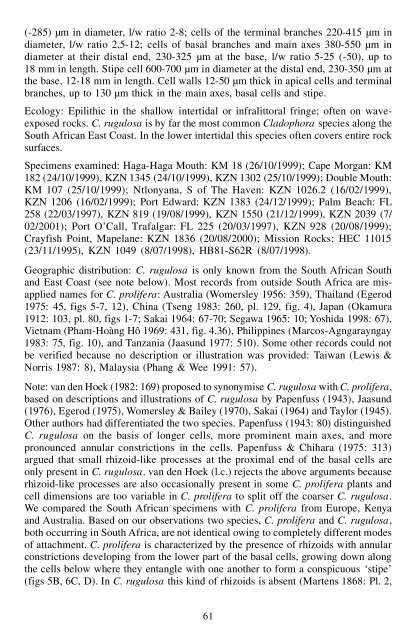The marine species of Cladophora (Chlorophyta) from the South ...
The marine species of Cladophora (Chlorophyta) from the South ...
The marine species of Cladophora (Chlorophyta) from the South ...
Create successful ePaper yourself
Turn your PDF publications into a flip-book with our unique Google optimized e-Paper software.
(-285) µm in diameter, l/w ratio 2-8; cells <strong>of</strong> <strong>the</strong> terminal branches 220-415 µm in<br />
diameter, l/w ratio 2,5-12; cells <strong>of</strong> basal branches and main axes 380-550 µm in<br />
diameter at <strong>the</strong>ir distal end, 230-325 µm at <strong>the</strong> base, l/w ratio 5-25 (-50), up to<br />
18 mm in length. Stipe cell 600-700 µm in diameter at <strong>the</strong> distal end, 230-350 µm at<br />
<strong>the</strong> base, 12-18 mm in length. Cell walls 12-50 µm thick in apical cells and terminal<br />
branches, up to 130 µm thick in <strong>the</strong> main axes, basal cells and stipe.<br />
Ecology: Epilithic in <strong>the</strong> shallow intertidal or infralittoral fringe; <strong>of</strong>ten on waveexposed<br />
rocks. C. rugulosa is by far <strong>the</strong> most common <strong>Cladophora</strong> <strong>species</strong> along <strong>the</strong><br />
<strong>South</strong> African East Coast. In <strong>the</strong> lower intertidal this <strong>species</strong> <strong>of</strong>ten covers entire rock<br />
surfaces.<br />
Specimens examined: Haga-Haga Mouth: KM 18 (26/10/1999); Cape Morgan: KM<br />
182 (24/10/1999), KZN 1345 (24/10/1999), KZN 1302 (25/10/1999); Double Mouth:<br />
KM 107 (25/10/1999); Ntlonyana, S <strong>of</strong> <strong>The</strong> Haven: KZN 1026.2 (16/02/1999),<br />
KZN 1206 (16/02/1999); Port Edward: KZN 1383 (24/12/1999); Palm Beach: FL<br />
258 (22/03/1997), KZN 819 (19/08/1999), KZN 1550 (21/12/1999), KZN 2039 (7/<br />
02/2001); Port O’Call, Trafalgar: FL 225 (20/03/1997), KZN 928 (20/08/1999);<br />
Crayfish Point, Mapelane: KZN 1836 (20/08/2000); Mission Rocks: HEC 11015<br />
(23/11/1995), KZN 1049 (8/07/1998), HB81-S62R (8/07/1998).<br />
Geographic distribution: C. rugulosa is only known <strong>from</strong> <strong>the</strong> <strong>South</strong> African <strong>South</strong><br />
and East Coast (see note below). Most records <strong>from</strong> outside <strong>South</strong> Africa are misapplied<br />
names for C. prolifera: Australia (Womersley 1956: 359), Thailand (Egerod<br />
1975: 45, figs 5-7, 12), China (Tseng 1983: 260, pl. 129, fig. 4), Japan (Okamura<br />
1912: 103, pl. 80, figs 1-7; Sakai 1964: 67-70; Segawa 1965: 10; Yoshida 1998: 67),<br />
Vietnam (Pham-Hoàng Hô 1969: 431, fig. 4.36), Philippines (Marcos-Agngarayngay<br />
1983: 75, fig. 10), and Tanzania (Jaasund 1977: 510). Some o<strong>the</strong>r records could not<br />
be verified because no description or illustration was provided: Taiwan (Lewis &<br />
Norris 1987: 8), Malaysia (Phang & Wee 1991: 57).<br />
Note: van den Hoek (1982: 169) proposed to synonymise C. rugulosa with C. prolifera,<br />
based on descriptions and illustrations <strong>of</strong> C. rugulosa by Papenfuss (1943), Jaasund<br />
(1976), Egerod (1975), Womersley & Bailey (1970), Sakai (1964) and Taylor (1945).<br />
O<strong>the</strong>r authors had differentiated <strong>the</strong> two <strong>species</strong>. Papenfuss (1943: 80) distinguished<br />
C. rugulosa on <strong>the</strong> basis <strong>of</strong> longer cells, more prominent main axes, and more<br />
pronounced annular constrictions in <strong>the</strong> cells. Papenfuss & Chihara (1975: 313)<br />
argued that small rhizoid-like processes at <strong>the</strong> proximal end <strong>of</strong> <strong>the</strong> basal cells are<br />
only present in C. rugulosa. van den Hoek (l.c.) rejects <strong>the</strong> above arguments because<br />
rhizoid-like processes are also occasionally present in some C. prolifera plants and<br />
cell dimensions are too variable in C. prolifera to split <strong>of</strong>f <strong>the</strong> coarser C. rugulosa.<br />
We compared <strong>the</strong> <strong>South</strong> African specimens with C. prolifera <strong>from</strong> Europe, Kenya<br />
and Australia. Based on our observations two <strong>species</strong>, C. prolifera and C. rugulosa,<br />
both occurring in <strong>South</strong> Africa, are not identical owing to completely different modes<br />
<strong>of</strong> attachment. C. prolifera is characterized by <strong>the</strong> presence <strong>of</strong> rhizoids with annular<br />
constrictions developing <strong>from</strong> <strong>the</strong> lower part <strong>of</strong> <strong>the</strong> basal cells, growing down along<br />
<strong>the</strong> cells below where <strong>the</strong>y entangle with one ano<strong>the</strong>r to form a conspicuous ‘stipe’<br />
(figs 5B, 6C, D). In C. rugulosa this kind <strong>of</strong> rhizoids is absent (Martens 1868: Pl. 2,<br />
61

















